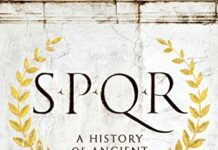
Ebook Info
- Published: 2010
- Number of pages: 240 pages
- Format: PDF
- File Size: 3.66 MB
- Authors: Mary Beard
Description
The ruined silhouette of the Parthenon on its hill above Athens is one of the world’s most famous images. Its ‘looted’ Elgin Marbles are a global cause celebre. But what actually are they? In a revised and updated edition, Mary Beard, award winning writer, reviewer and leading Cambridge classicist, tells the history and explains the significance of the Parthenon, the temple of the virgin goddess Athena, the divine patroness of ancient Athens.
User’s Reviews
Reviews from Amazon users which were colected at the time this book was published on the website:
⭐This is an exhaustive, fabulous treatise on one of the most venerable monuments to classical history the world has ever known. Beard takes us through the entire history of the Parthenon. She details for us its probable early use as a temple to Athena (as well as some other theories) as well as its less known utility as a Christian church and Mosque in later ages.Along the way, Beard offers us statements concerning the Parthenon from various historical and modern personages. Some are profound, some are not. Some simply advertise their ignorance (such as the not-so-venerable Shaquille O’Neal). From the vantage points of different epochs we are able to discern how the Parthenon has been seen down through the ages.Of course, no work on the Parthenon would be complete without examining the highly(!) controversial exploits of one Lord Elgin. As hoped, Beard delivers in giving a thorough description of all the forces at play in both England & Greece. She does not take a position on the issue, so her discussion of this sensitive topic is not apt to offend anyone. Then again, since she refrains from taking a position, perhaps that in itself WILL offend some people? I don’t know.There is also a background section on the disastrous explosion of 1687. It was caused by the Ottoman Empire using (mis-using!) the Parthenon as an arsenal. Not suprisingly, this made it a target for the Venetians and…..you can guess the rest. What is less known is that 300 people perished when the Parthenon exploded. That’s an unfortunate detail that is many times overlooked in history classes. As usual, Beard does an excellent job of giving the whole story of what took place.If you possess an interest in the Parthenon and / or ancient Greece in general, this book is a can’t miss. For anyone who wishes to tour Greece (or the British museum in London), this book is highly recommended as well. Even if you only have a passing interest in history per-se, this book will give you an avenue to enjoy the Parthenon & all of its frieze and sculptoral splendor.
⭐I have been teaching the Parthenon in college courses for more than 30 years. Mary Beard opened my eyes to completely unsuspected aspects of the building, including its adaptation as a Christian church and an Islamic mosque. The chapter on restoration history is a revelation. Beard is her usual sardonic self, combining healthy scepticism with solid scholarship.
⭐Simply commenting on the writing style: very well done. Follows Strunk & White’s Elements of Style. Factual too. Every point is rebutted by a counter point, giving a nuianced view. I don’t usually give a book five stars (see my other reviews) but this one merits it.
⭐It’s interesting learning about the Parthenon, even if its required for my art history class. Love how its easy to carry!
⭐Must have book especially if you are going to Greece.
⭐Good Book!
⭐It is the most famous building in Western history. Yet, in _The Parthenon_ (Harvard University Press), Mary Beard reminds us that there are great voids of mystery about it, that we don’t know what large portions of it looked like when it was built, and that much of what we see when we look at the ruin now is a controversial restoration. Beard’s serious, academic, but witty monograph makes us look at the ruin again, and realize the role it has played in imagination and in objective Western history. Not only is the Parthenon an amazing and influential building, but it has a few thousand years of history and controversy (starting from before it was built). Beard gives us all the details in a lively account.Beard, a classicist, reminds us that we have to do a lot of guesswork about the Athenian government of the fifth century BCE, even though it looms large in our imagined history of democracy. There were rumors of financial and sexual scandal connected to the project, which was attacked as a colossal waste of money and “dressing up Athens like a whore.” The temple was not for worship such as occurs in our churches and mosques (both of which, in time, the Parthenon became). It was a strongbox, a place to keep not only the valuable statue secure, but also plenty of other treasures. The friezes were attacked by Christians when it was turned into a church, and had milder defacement from the Turks when it afterward became a mosque. The temple was more or less intact, though, until 1687, when Christians blew up the gunpowder the Turks were storing there. The ruin we see now on the Acropolis is not the ruin that was left. We now see columns running between the pedimented ends of the building, but this is a reconstruction from the 1920s. To put it mildly, this restoration did not meet the current standards for historic preservation, although it was heartily approved at the time. It is not an accurate reconstruction but “a plausible fiction” made of materials that were to hand, and it inexcusably injured the ancient blocks. Current reconstruction will position them as well as current research methods can direct.Of course the history of the Lord Elgin and his theft or rescue of the sculptures is recounted here in very fair detail. What happened to them in the twentieth century, however, shows how large a role they play in the world’s affections and interest. The rich art dealer Joseph Duveen provided the new accommodation for the Elgin Marbles at the British Museum. He somehow had access to the sculptures being prepared for their new accommodation, and in 1938, the director of the museum was horrified to find that copper tools and carborundum were being used to clean the figures at Duveen’s direction. Beard reports that “… heads did, discretely, roll, and ‘remedial measures’ (the phrase alone makes you shudder) were taken on the marbles.” There was a flurry of press criticism at the time, but a scholar turned the story up only a few years ago, resulting in an angry and emotional international conference to try to get to the bottom of the events of 1938. Beard says this is only the most recent climax of “the longest-running cultural controversy in the world,” the fate of the Elgin Marbles. The Parthenon may be only a ruin, but it plays a role in the world’s cares beyond just being a beautiful spot for sightseers. Beard’s biography of the building, erudite and vigorous, shows just why the Parthenon looms important among humanity’s monuments.
⭐Its worth a read. It gives a good overall account of the history of the Parthenon and I did learn a few interesting points like its post-temple history.But Beard’s general scepticism towards ancient Greece and Hellenephilism shines through and I think undermines the account. An enthusiastic analytical approach would have been engaging – like her works on Rome. You always get the feeling that she thinks that the Greeks were too ‘full of themselves’ and its all a bit of a fraud.
⭐Mary Beard’s book is witty, erudite and challenging. She is never dull, and we learn by stealth! We do not see what the ancient Greeks saw, but we are moved. Yet we can also paradoxically visit it in the British Museum. Freud believed that the Parthenon transcended space and time. Was he right?
⭐Opened my eyes to what has happened to these old stones. What we see now and what she has been though is to our eyes now a tragedy… Makes you understand why the British museum are hanging onto the Elgin marbles..
⭐this is a really enjoyable and comprehensive run through the history of the Parthenon and its sculptures, reviewing what is actually known of its original purpose and the context of its construction, from what original sources remain, and covering its fate through the ages. it also covers the modern debate over the ownership of the marbles held in various museums and describes the new museum in Athens, down to practical details of how sculptures are displayed with reference to their original position on the building. If the magic of the Parthenon has touched you, read this excellent book
⭐An interesting and readable account of the history of the Parthenon from its building and original purpose to the present day. It includes a lively and non partisan story of the Elgin marbles and their ongoing saga.
Keywords
Free Download The Parthenon in PDF format
The Parthenon PDF Free Download
Download The Parthenon 2010 PDF Free
The Parthenon 2010 PDF Free Download
Download The Parthenon PDF
Free Download Ebook The Parthenon





